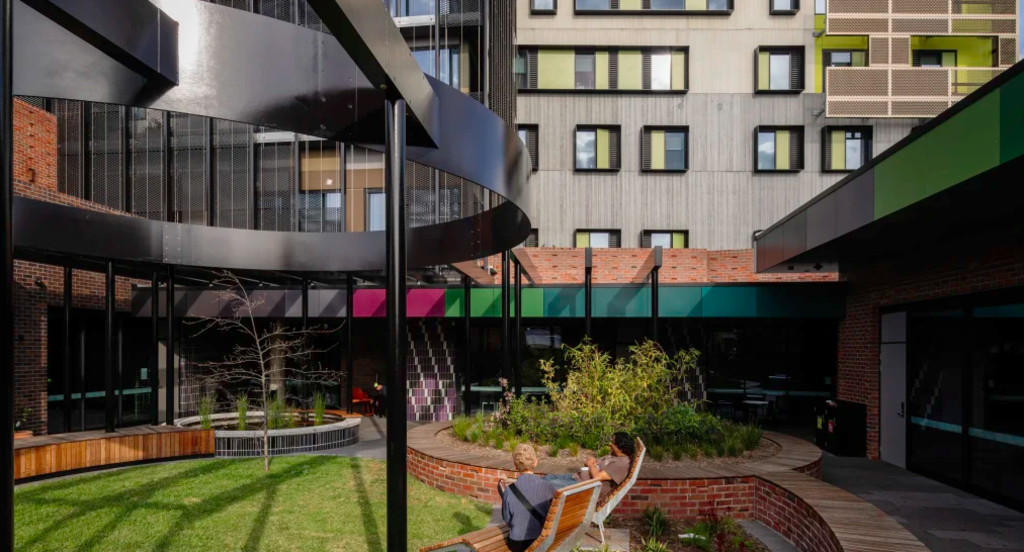
5-star Green Star building welcomes homeless
Ozanam House, named after Antoine-Frederic Ozanam, founder of the Society of Saint Vincent de Paul, is enmeshed into Vincent Care’s history, accommodating those struggling to find shelter.
Many were given a roof and a place to sleep in the former three-storey 1970s building on this site on Flemington Road, North Melbourne.
However, numbers were limited and the accommodation rudimentary.
So it was timely to look at a new scheme, where the rooms were increased and a variety of amenities included.
“Prior to this facility, people would often have to visit three disparate locations, whether it was medical, psychological or the dentist looking after the more disadvantaged in our community,” says architect Eli Giannini, a director of MGS Architects.
Giannini collaborated with a number of colleagues, including architect Sue Buchannan, an associate, responsible for the interiors and directors architect Joshua Wheeler and Rob McGauran, the latter responsible for Ozanam House’s master planning and urban design.
“It’s a large and complex project, something that would not have been possible without State Government and generous private funding,” adds Giannini.
MGS Architects brief for this new centre came from the previous CEO of VincentCare John Blewonski. The former 1970s building not only lacked any amenities or services but was also limited to men.
“The idea for this place was that people of all genders could stay short, medium and long term, as well as providing a place for those sleeping rough.
They can walk in off the street, take a shower, have a meal or even spend some time in the garden (designed by Outlines Landscape Architects),” says Buchannan.
“It was important that people coming here don’t feel intimidated, are welcomed and not ???interrogated’ when they first arrive,” she adds.
Rather than create one monolithic tower that resembled a private apartment block (as is the case with the neighbouring 1960s apartments), MGS Architects designed a layered building.
It’s anchored by a variety of textured and patterned bricks on the lower levels containing the services: a library, a cafe, meeting rooms, a recreation room with a table tennis, a gymnasium and importantly, all the services, such as medical, provided in-house.
Rather than the high-brick wall that existed in the former arrangement, now there’s a level of transparency that connects people to the neighbourhood.
While the lower levels are brick, the majority of the upper levels are concrete, with bronze mesh screens on balconies that will eventually be covered in vines.
“We staggered the floors to respond not only to the neighbouring apartments but also to the lower scale terraces on Flemington Road,” says Giannini.
MGS Architects also created a separate point of arrival for residents in order to develop a sense of home, with brightly coloured tiles forming a sense of arrival.
Wide corridors, places to sit along the way, and lounge areas on every level for the 134 units (ranging from 25 to 50 square metres) create something that’s well beyond a room to sleep.
Given where many residents have come from, creating a sense of calmness was also paramount.
“One resident recently said at how quiet it is living here.
There’s literally no sound from outside once the front door to his unit is closed,” says Giannini.
Inside each suite there’s a bathroom, a kitchenette and some of Melbourne’s finest views, either of the city skyline or overlooking Royal Park.
“We were also mindful of creating a sustainable footprint,” says Buchanan, proud of Ozanam House’s 5 star green star rating.
Ozanam House has given dignity back to those in desperate need of accommodation.
It’s also an exemplary example that housing of this nature need not be conceived as institutionalised, with people feeling alienated, rather than part of a community, both within the building and the surrounding neighbourhood.
Even the cafe at ground level, is operated by residents, many of whom lived in the former Ozanam House.
“Whether people drop in for coffee or spend time just enjoying the gardens, there’s literally a place for everyone,” adds Giannini.











